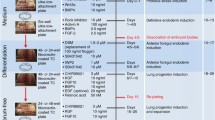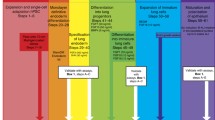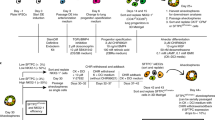Abstract
Airway epithelial cells derived from induced pluripotent stem (iPS) cells are expected to be a useful source for the regeneration of airway epithelium. Our preliminary study of embryoid body (EB) formation and the air-liquid interface (ALI) method suggested that mouse iPS cells can differentiate into airway epithelial cells. However, whether the cells generated from mouse iPS cells had the character and phenotype of native airway epithelial cells remained uninvestigated. In this study, we generated airway epithelial cells from EBs by culturing them under serum-free conditions supplemented with Activin and bFGF and by the ALI method and characterized the iPS cell-derived airway epithelial cells in terms of their gene expression, immunoreactivity, morphology, and function. Analysis by quantitative real-time reverse transcription-polymerase chain reaction(RT-PCR) revealed that the expression of the undifferentiated cell marker Nanog decreased time-dependently after the induction of differentiation, whereas definitive endoderm markers Foxa2 and Cxcr4 were transiently up-regulated. Thereafter, the expression of airway epithelium markers such as Tubb4a, Muc5ac, and Krt5 was detected by RT-PCR and immunostaining. The formation of tight junctions was also confirmed by immunostaining and permeability assay. Analysis by hematoxylin and eosin staining and scanning electron microscopy indicated that the cells generated from mouse iPS cells formed airway-epithelium-like tissue and had cilia, the movement of which was visualized and observed to be synchronized. These results demonstrate that the airway epithelial cells generated by our method have native characteristics and open new perspectives for the regeneration of injured airway epithelium.







Similar content being viewed by others
References
Afzelius BA (1976) A human syndrome caused by immotile cilia.Science 193:317-319
Bellusci S, Grindley J, Emoto H, Itoh N, Hogan BL (1997) Fibroblast growth factor 10 (FGF10) and branching morphogenesis in the embryonic mouse lung. Development 124:4867–4878
Bettiol E, Sartiani L, Chicha L, Krause KH, Cerbai E, Jaconi ME (2007) Fetal bovine serum enables cardiac differentiation of human embryonic stem cells. Differentiation 75:669–681
Chambers LA, Roillins BM, Tarran R (2007) Liquid movement across the surface epithelium of large airways. Respir Physiol Neurobiol 159:256–270
Coraux C, Nawrocki-Raby B, Hinnrasky J, Kileztky C, Gaillard D, Dani C, Puchelle E (2005) Embryonic stem cells generate airway epithelial tissue. Am J Respir Cell Mol Biol 32:87–92
Evans MJ, Kaufman MH (1981) Establishment in culture of pluripotential cells from mouse embryos. Nature 292:154–156
Fanning AS, Ma TY, Anderson JM (2002) Isolation and functional characterization of the actin binding region in the tight junction protein ZO-1. FASEB J 16:1835–1837
Firth AL, Dargitz CT, Qualls SJ, Menon T, Wright R, Singer O, Gage FH, Khanna A, Verma IM (2014)Generation of multiciliated cells in functional airway epithelia from human induced pluripotent stem cells.Proc Natl Acad Sci U S A 111:E1723-E1730
Gerdes JM, Davis EE, Katsanis N (2009) The vertebrate primary cilium in development, homeostasis, and disease. Cell 137:32–45
Goedecke DM, Elston TC (2005) A model for the oscillatory motion of single dynein molecules. J Theor Biol 232:27–39
Huang SX, Islam MN, O’Neill J, Hu Z, Yang YG, Chen YW, Mumau M, Green MD, Vunjak-Novakovic G, Bhattacharya J, Snoeck HW (2014) Efficient generation of lung and airway epithelial cells from human pluripotent stem cells. Nat Biotechnol 32:84–91
Ibanez-Tallon I, Heintz N, Omran H (2003) To beat or not to beat: roles of cilia in development and disease. Hum Mol Genet 12:R27–R35
Imaizumi M, Nomoto Y, Sato Y, Sugino T, Miyake M, Wada I, Nakamura T, Omori K (2013) Evaluation of the use of induced pluripotent stem cells (iPSCs) for the regeneration of cartilage. Cell Transplant 22:341–353
Kim PT, Hoffman BG, Plesner A, Helgason CD, Verchere CB, Chung SW, Warnock GL, Mui AL, Ong CJ (2010) Differentiation of mouse embryonic stem cells into endoderm without embryoid body formation. PLoS One 5:e14146
Kimura J, Deutsch GH (2007) Key mechanisms of early lung development. Pediatr Dev Pathol 10:335–347
Knowles MR, Boucher RC (2002) Mucus clearance as a primary innate defense mechanism for mammalian airways. J Clin Invest 109:571–577
Laitinen LA, Heino M, Laitinen A, Kava T, Haahtela T (1985) Damage of the airway epithelium and bronchial reactivity in patients with asthma. Am Rev Respir Dis 131:599–606
Macpherson H, Keir P, Webb S, Samuel K, Boyle S, Bickmore W, Forrester L, Dorin J (2005) Bone marrow-derived SP cells can contribute to the respiratory tract of mice in vivo. J Cell Sci 118:2441–2450
Martinod E, Seguin A, Radu DM, Boddaert G, Chouahnia K, Fialaire-Legendre A, Dutau H, Venissac N, Marquette CH, Baillard C, Valeyre D, Carpentier A (2013) Airway transplantation: a challenge for regenerative medicine. Eur J Med Res 29:18–25
Minno P, Su G, Drum H, Bringas P, Kimura S (1999) Defects in tracheoesophageal and lung morphogenesis in Nkx2.1(-/-) mouse embryos. Dev Biol 209:60–71
Mirzadeh Z, Merkle FT, Soriano-Navarro M, Garcia-Verdugo JM, Alvarez-Buylla A (2008) Neural stem cells confer unique pinwheel architecture to the ventricular surface in neurogenic regions of the adult brain. Cell Stem Cell 3:265–278
Okita K, Ichisaka T, Yamanaka S (2007) Generation of germline-competent induced pluripotent stem cells. Nature 448:313–317
Omori K, Nakamura T, Kanemaru S, Asato R, Yamashita M, Tanaka S, Magrufov A, Ito J, Shimizu Y (2005) Regenerative medicine of the trachea: the first human case. Ann Otol Rhinol Laryngol 114:429–433
Otsuki K, Imaizumi M, Nomoto Y, Wada I, Miyake M, Sugino T, Omori K (2013) Potential for respiratory epithelium regeneration from induced pluripotent stem cells. Ann Otol Rhinol Laryngol 122:25–32
Otsuki K, Imaizumi M, Nomoto Y, Nomoto M, Wada I, Miyake M, Omori K (2014) Effective embryoid body formation from induced pluripotent stem (iPS) cells for regeneration of respiratory epithelium. Laryngoscope 124:E8–E14
Pan Q, Li C, Xiao J, Kimura S, Rubenstein J, Puelles L, Minoo P (2004) In vivo characterization of the Nkx2.1 promoter/enhancer elements in transgenic mice. Gene 331:73–82
Schoch KG, Lori A, Burns KA, Eldred T, Olsen JC, Randell SH (2004) A subset of mouse tracheal epithelial basal cells generates large colonies in vitro. Am J Physiol Lung Cell Mol Physiol 286:L631–L642
Séguin CA, Draper JS, Nagy A, Rossant J (2008) Establishment of endoderm progenitors by SOX transcription factor expression in human embryonic stem cells. Cell Stem Cell 3:182–195
Shiba Y, Fernandes S, Zhu WZ, Filice D, Muskheli V, Kim J, Palpant NJ, Gantz J, Moyes KW, Reinecke H, Van Bider B, Dardas T, Mignone JL, Izawa A, Hanna R, Viswanathan M, Gold JD, Kotlikoff MI, Sarvazyan N, Kay MW, Murry CE, Laflamme MA (2012) Human ES-cell-derived cardiomyocytes electrically couple and suppress arrhythmias in injured hearts. Nature 489:322–325
Shiratori M, Oshika E, Ung LP, Singh G, Shinozuka H, Warburton D, Michalopoulos G, Katyal SL (1996) Keratinocyte growth factor and embryonic rat lung morphogenesis. Am J Respir Cell Mol Biol 15:328–338
Smukler SR, Runciman SB, Xu S, Kooy D van der (2006) Embryonic stem cells assume a primitive neural stem cell fate in the absence of extrinsic influences. J Cell Biol 172:79–90
Taha MF, Valojerdi MR (2008) Effect of bone morphogenetic protein-4 on cardiac differentiation from mouse embryonic stem cells in serum-free and low-serum media. Int J Cardiol 127:78–87
Takahashi K, Yamanaka S (2006) Induction of pluripotent stem cells from mouse embryonic and adult fibroblast cultures by defined factors. Cell 126:663–676
Takebe T, Sekine K, Enomura M, Koike H, Kimura M, Ogaeri T, Zhang RR, Ueno Y, Zheng YW, Koike N, Aoyama S, Adachi Y, Taniguchi H (2013) Vascularized and functional human liver from an iPSC-derived organ bud transplant. Nature 499:481–484
Vincent SD, Dunn NR, Hayashi S, Norris DP, Robertson EJ (2003) Cell fate decisions within the mouse organizer are governed by graded Nodal signals. Genes Dev 17:1646–1662
Walters RW, Grunst T, Bergelson JM, Finberg RW, Welsh MJ, Zabner J (1999) Basolateral localization of fiber receptors limits adenovirus infection from the apical surface of airway epithelia. J Biol Chem 274:10219–10226
Weaver M, Yingling JM, Dunn NR, Bellusci S, Hogan BL (1999) Bmp signaling regulates proximal-distal differentiation of endoderm in mouse lung development. Development 126:4005–4015
Wong AP, Bear CE, Chin S, Pasceri P, Thompson TO, Huan LJ, Ratjen F, Ellis J, Rossant J (2012) Directed differentiation of human pluripotent stem cells into mature airway epithelia expressing functional CFTR protein. Nat Biotechnol 30:876–882
Wurtz A, Porte H, Conti M, Desbordes J, Copin MC, Azorin J, Martinod E, Marquette CH (2006) Tracheal replacement with aortic allografts. N Engl J Med 18:1938–1940
Xia Y, Nivet E, Sancho-Martinez I, Gallegos T, Suzuki K, Okamura D, Wu MZ, Dubova I, Esteban CR, Montserrat N, Campistol JM, Izpisua Belmonte JC (2013) Directed differentiation of human pluripotent cells to ureteric bud kidney progenitor-like cells. Nat Cell Biol 15:1507–1515
Xu L, Zhang S, Li J, Liu J, Liu H, Huang W, Shang X (2014) Human tracheal allotransplant with greater omentum for revascularization. Exp Clin Transplant 12:448–453
Acknowledgment
We thank Ms. Etsuko Sato for excellent technical assistance.
Author information
Authors and Affiliations
Corresponding author
Additional information
This study was supported by Grant-in-Aid for Challenging Exploratory Research 24659751, Grant-in-Aid for Scientific Research (B) 26293371, and Fukushima Medical University.
Electronic supplementary material
Below is the link to the electronic supplementary material.
Ciliary movement of mouse iPS-cell-derived airway epithelial cells. The bright-field images of the beating cilia were captured at 200 frames/s. The movie is shown at 30 frames/s. Bar 10 μm. (AVI 29523 kb)
Ciliary movement of mouse trachea. The bright-field images of the beating cilia were captured at 200 frames/s. The movie is shown at 30 frames/s. Bar 10 μm. (MOV 10041 kb)
Coordination of ciliary movement of mouse iPS-cell-derived airway epithelial cells. The movie is shown at 30 frames/s. Bar 200 μm. (MOV 10041 kb)
Rights and permissions
About this article
Cite this article
Yoshie, S., Imaizumi, M., Nakamura, R. et al. Generation of airway epithelial cells with native characteristics from mouse induced pluripotent stem cells. Cell Tissue Res 364, 319–330 (2016). https://doi.org/10.1007/s00441-015-2304-7
Received:
Accepted:
Published:
Issue Date:
DOI: https://doi.org/10.1007/s00441-015-2304-7




